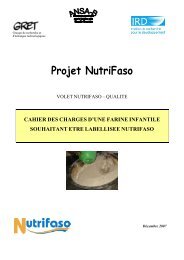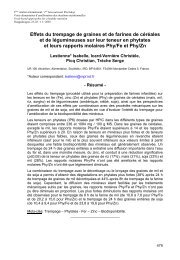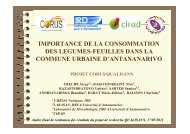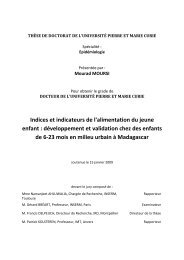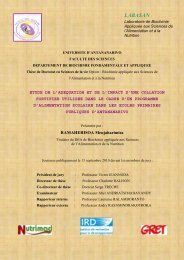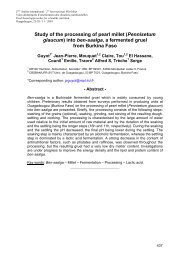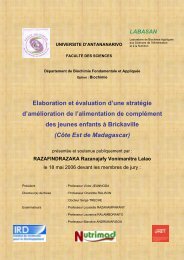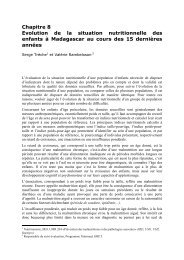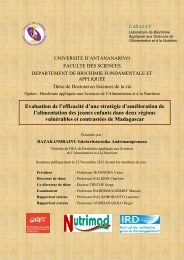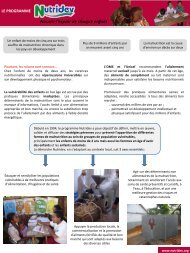THESE UNIQUE El Hassane Kéhien-Piho TOU - Nutridev
THESE UNIQUE El Hassane Kéhien-Piho TOU - Nutridev
THESE UNIQUE El Hassane Kéhien-Piho TOU - Nutridev
Create successful ePaper yourself
Turn your PDF publications into a flip-book with our unique Google optimized e-Paper software.
1568<br />
ARTICLE IN PRESS<br />
E.H. Tou et al. / LWT 40 (2007) 1561–1569<br />
Onyango et al., 2005). However, the incorporation of<br />
groundnuts could present the risk of mycotoxin contamination<br />
of the gruel if storage conditions are not appropriate.<br />
To prevent contamination, it is important to sort<br />
the groundnuts before processing and to remove any<br />
mouldy seeds.<br />
In all three types of gruels, a decrease in fibre content<br />
was observed after processing. This might be due to the<br />
sieving step when the draff was eliminated. Decreases in<br />
phytate content of 68%, 50% and 66% in control, MG-T<br />
and MG-CMI gruels, respectively, were observed during<br />
the course of processing, probably due to microbial<br />
phytase activity during fermentation. These results are<br />
consistent with those reported in lactic acid fermented<br />
maize (Lopez, Gordon, & Fields, 1983) and pearl millet<br />
(Mahajan & Chauhan, 1987; Agte, Khot, Joshi, Chiplonkar,<br />
& Paknikar, 1998). The phytate content in the MG-<br />
CMI and MG-T samples was higher than in the control<br />
(192 mg) due to the high phytate content of groundnuts.<br />
Agte, Tarwadi, and Chiplonkar (1999) also reported that<br />
the addition of legumes such as groundnuts or soybean<br />
increases the total phytate content. Nevertheless, the<br />
phytate content in both MG samples was less than that<br />
of the raw millet. The phytate content in the MG-CMI<br />
samples (297 mg) was significantly (Po0.05) lower than in<br />
the MG-T sample. This could be due to the combined<br />
action of malt and microbial phytase.<br />
3.3.2. Energy density of gruels<br />
The DM contents of traditional ben-saalga and gruels<br />
prepared using the MG-T and MG-CMI processes at the<br />
same Bostwick consistency of 120 mm/30 s were 8.6, 9.8<br />
and 25.6 g/100 g, respectively; these values correspond to<br />
gruels with an ED of 35.0, 45.3 and 117.3 kcal/100 g of<br />
sweetened gruels, respectively. Thus, due to the high DM<br />
energy value of MG-blend (Table 3), MG-T gruels had<br />
higher ED than ben-saalga. However, the increase was<br />
limited and ED of MG-T gruels (45.3 kcal/100 g) remained<br />
far below the value of 84 kcal/100 g of gruel recommended<br />
for complementary food (Dewey & Brown, 2003). This<br />
demonstrates that the MG-CMI processing method should<br />
be used to achieve a substantial improvement in gruel ED<br />
and macronutrient balance.<br />
4. Conclusion<br />
The two processing methods for a millet–groundnut<br />
blend experimented in this study enabled a gruel with<br />
appropriate macronutrient content to be obtained. However,<br />
only the MG-CMI processing method enabled<br />
preparation of gruel with the appropriate balance of<br />
macronutrients and high energy density at a suitable<br />
consistency. Although considerable changes are proposed<br />
compared to the traditional processing method of bensaalga,<br />
the fermentation kinetics remains similar except<br />
that lactic acid production is exacerbated by the higher<br />
glucose and maltose contents. High final maltose and lactic<br />
acid concentrations in the improved MG-CMI gruel may<br />
have consequences for its organoleptic characteristics such<br />
as enhancement of the sweet and/or sour tastes, so the<br />
acceptability of the improved gruel needs to be assessed.<br />
In addition, the high final maltose concentration in the<br />
MG-CMI gruel associated with a low final pH present a<br />
risk of post-contamination by spoilage yeasts, with possible<br />
product alteration if storage conditions are not appropriate.<br />
In this respect, the shelf-life of the final product<br />
needs to be further investigated.<br />
Acknowledgements<br />
This work was performed within the framework of<br />
the Cerefer project (www.mpl.ird.fr/cerefer/) funded by<br />
the European Commission, Contract No. ICA4-CT-2002-<br />
10047.<br />
References<br />
ACC/SCN (2000). Commission on the nutrition challenges of the 21th<br />
century. Ending malnutrition by 2020: An agenda for change in the<br />
Millennium. Food and Nutrition Bulletin Supplement, 21(3), 88.<br />
AFNOR (1970). Directives ge´ne´rales pour le dosage de l’azote avec<br />
mine´ralisation selon la méthode Kjeldahl (produits agricoles alimentaires).<br />
Norme NF V 03-050.<br />
Agte, V. V., Khot, S., Joshi, S., Chiplonkar, S. A., & Paknikar, K. M.<br />
(1998). Effect of traditional processing of legumes on trace metal<br />
bioavailability. Journal of Food Sciences and Technology, 35, 330–332.<br />
Agte, V. V., Tarwadi, K., & Chiplonkar, S. A. (1999). Phytate degradation<br />
during traditional cooking: Significance of the phytic acid profile in<br />
cereal-based vegetarian meals. Journal of Food Composition and<br />
Analysis, 12, 161–167.<br />
Blandino, A., Al-Aseeri, M. E., Pandiella, S. S., Cantero, D., & Webb, C.<br />
(2003). Cereal-based fermented foods and beverages. Food Research<br />
International, 36, 527–543.<br />
Calderon, M., Loiseau, G., & Guyot, J. P. (2001). Nutritional requirements<br />
and simplified cultivation medium to study growth and<br />
energetics of a sourdough lactic acid bacterium Lactobacillus<br />
fermentum Ogi E1 during heterolactic fermentation of starch. Journal<br />
of Applied Microbiology, 90, 508–516.<br />
Cornu, A., Trèche, S., Massamba, J., & Delpeuch, F. (1993). Alimentation<br />
de sevrage et interventions nutritionnelles au Congo. Cahiers Santé, 3,<br />
168–177.<br />
Dewey, K. G., & Brown, K. H. (2003). Update on technical issues<br />
concerning complementary feeding of young children in developing<br />
countries and implications for intervention programs. Food and<br />
Nutrition Bulletin, 24(1), 5–28.<br />
Duncan, D. B. (1955). Multiple range and multiple-F tests. Biometrics,<br />
11, 1.<br />
Egounlety, M. (2002). Production of legume-fortified weaning foods. Food<br />
Research International, 35, 233–237.<br />
Egounlety, M., & Aworh, O. C. (1995). Changes in oligosaccharides<br />
during fermentation of soybean (Glycine max Merr.), cowpea (Vigna<br />
unguiculata L. Walp) and groundbean (Macrotyloma geocarpa Harms).<br />
Paper presented at the ninth world congress of food science &<br />
technology. Budapest, Hungary, 30 July–August 3.<br />
Institut National de la Statistique et de la Démographie (INSD), & Macro<br />
International (2004). Enquête Démographique et de Santé (EDS),<br />
Burkina Faso. In G. S. Mariko (Ed.), Allaitement et Etat Nutritionnel<br />
(pp. 145–172).<br />
Kingamkono, R., Sjo¨gren, E., Svanberg, U., & Kaijser, B. (1994). pH and<br />
acidity in lactic-fermenting cereal gruels: Effects on viability of



